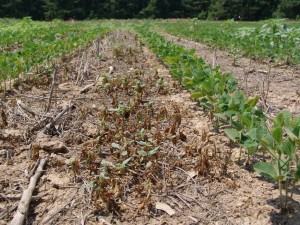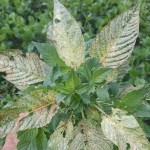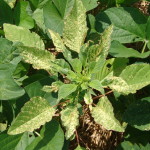Identification of PPO-resistant Palmer amaranth has been a concern for many over the past couple of weeks. I am sure many of the Palmer amaranth escapes in West Tennessee are not due to resistance. However some definitely are. We are up to 4 counties now where the Palmer amaranth with the PPO-resistant gene has been identified. So how can one tell if Palmer amaranth that escapes FlexStar, Ultra Blazer or Cobra is due to resistance or another issue?
In most resistant weed cases it is a long process to determine if herbicide resistance is the problem. This particular case appears to be easier to identify by observing how the Palmer amaranth reacts after a POST PPO herbicide application.
PPO-resistant Palmer amaranth shows distinct symptomology after a PPO herbicide application that is very different than what occurs due to the weed being too large at time of application.

Typically, when a PPO herbicide is applied to Palmer amaranth larger than 3” (too large) the pigweed has every leaf burned off in 24 to 48 hours and the apical meristem is taken out. The plant recovers by putting out new growth on lower axillary nodes (Picture right). Palmer amaranth that has the PPO-resistant gene does not react like this.
PPO-resistant Palmer amaranth leaves sprayed POST will not burn but rather the leaf will show white flecking that varies in severity from minor to more pronounced. In some cases these leaves will go ahead and fall off but it will take days for this to happen if it happens at all. In the meantime, new growth comes out of the apical meristem unchecked with a very healthy green color (Pictures below).
We are still in the process of taking leaf samples from Palmer amaranth that looks like the pictures above and checking them for the PPO-resistant gene. So far the results have been close to a 100%.
So what should you do if you find some of your Palmer amaranth looks like it is resistant? A good first step would be to contact your county agent, retailer or crop consultant and start making pigweed management plans for next year.



